Impact of Leadership Styles on Nursing: A Literature Review Report
VerifiedAdded on 2023/03/17
|11
|2740
|100
Report
AI Summary
This report presents a comprehensive literature review of leadership and management in nursing, analyzing four academic articles that explore the influence of different leadership styles on nursing practice. The review focuses on transformational and servant leadership, highlighting their positive impacts on job satisfaction, patient safety, and the overall work environment. It contrasts these styles with abusive leadership, examining its negative consequences on novice nurses and the quality of care. The report also discusses the relevance of research findings in the context of leadership development in nursing, offering insights into how to create a safe and conducive environment for nursing practice. The conclusion emphasizes the importance of relational leadership styles for improving healthcare systems and adapting to rapid changes in the field.
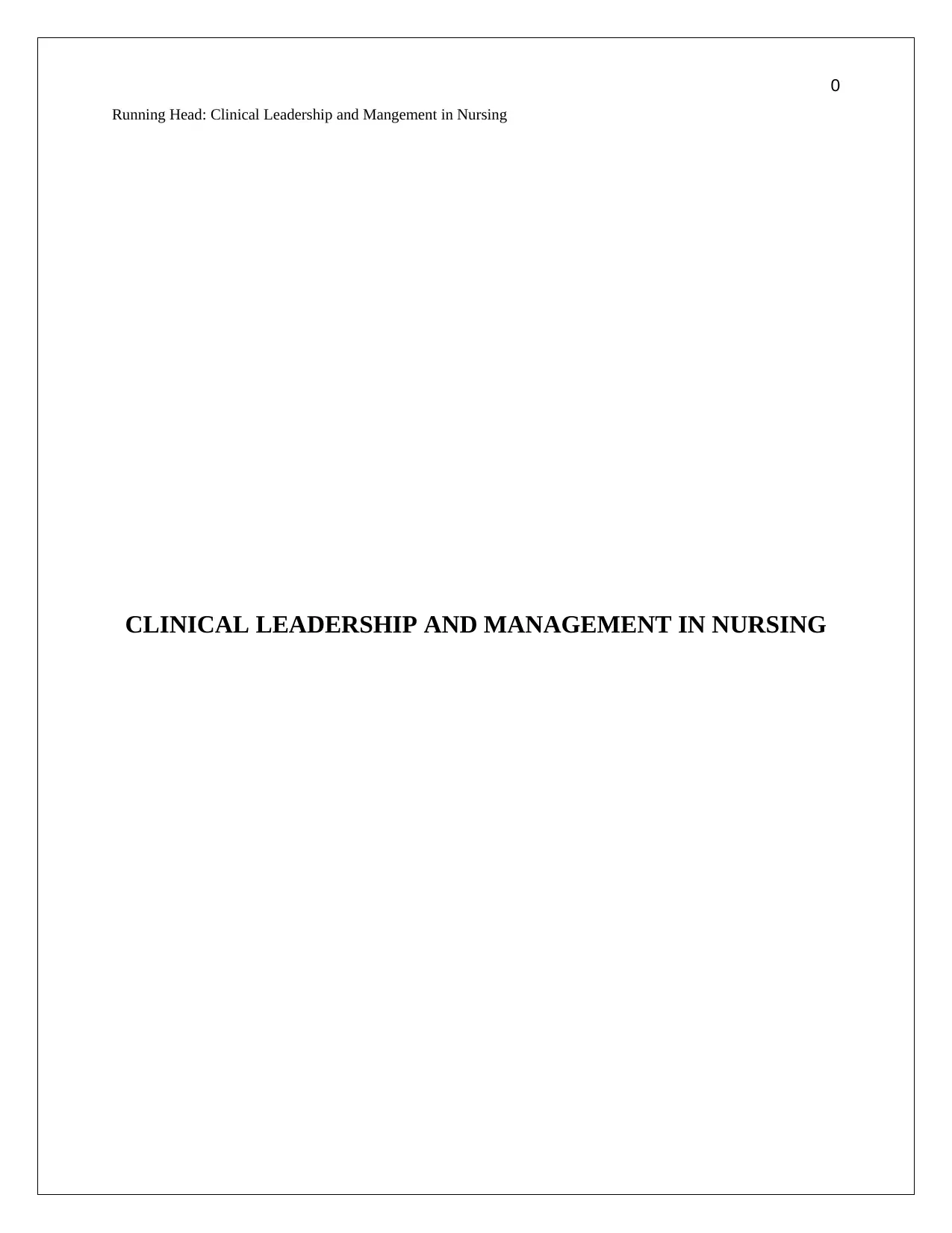
0
Running Head: Clinical Leadership and Mangement in Nursing
CLINICAL LEADERSHIP AND MANAGEMENT IN NURSING
Running Head: Clinical Leadership and Mangement in Nursing
CLINICAL LEADERSHIP AND MANAGEMENT IN NURSING
Paraphrase This Document
Need a fresh take? Get an instant paraphrase of this document with our AI Paraphraser
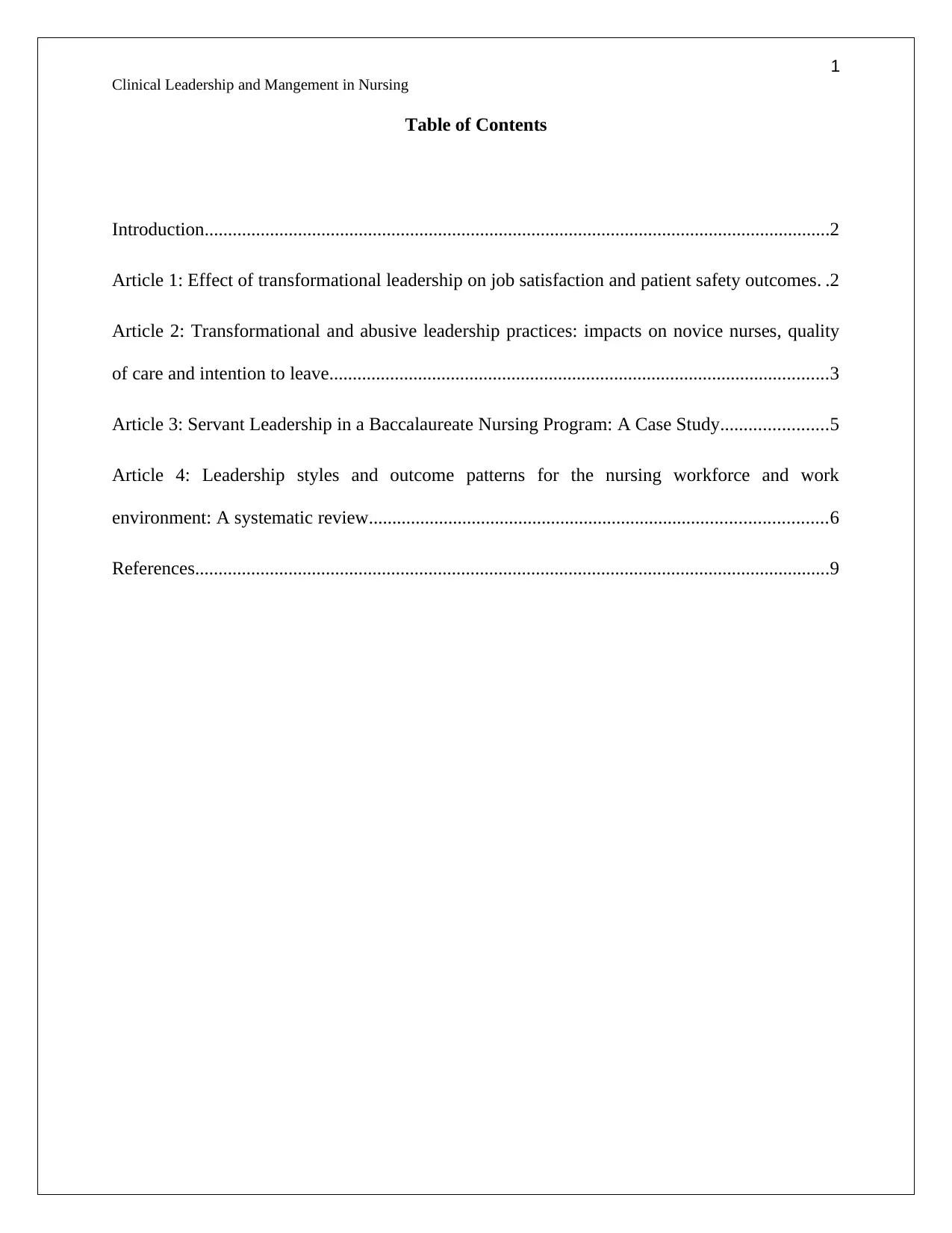
1
Clinical Leadership and Mangement in Nursing
Table of Contents
Introduction......................................................................................................................................2
Article 1: Effect of transformational leadership on job satisfaction and patient safety outcomes. .2
Article 2: Transformational and abusive leadership practices: impacts on novice nurses, quality
of care and intention to leave...........................................................................................................3
Article 3: Servant Leadership in a Baccalaureate Nursing Program: A Case Study.......................5
Article 4: Leadership styles and outcome patterns for the nursing workforce and work
environment: A systematic review..................................................................................................6
References........................................................................................................................................9
Clinical Leadership and Mangement in Nursing
Table of Contents
Introduction......................................................................................................................................2
Article 1: Effect of transformational leadership on job satisfaction and patient safety outcomes. .2
Article 2: Transformational and abusive leadership practices: impacts on novice nurses, quality
of care and intention to leave...........................................................................................................3
Article 3: Servant Leadership in a Baccalaureate Nursing Program: A Case Study.......................5
Article 4: Leadership styles and outcome patterns for the nursing workforce and work
environment: A systematic review..................................................................................................6
References........................................................................................................................................9
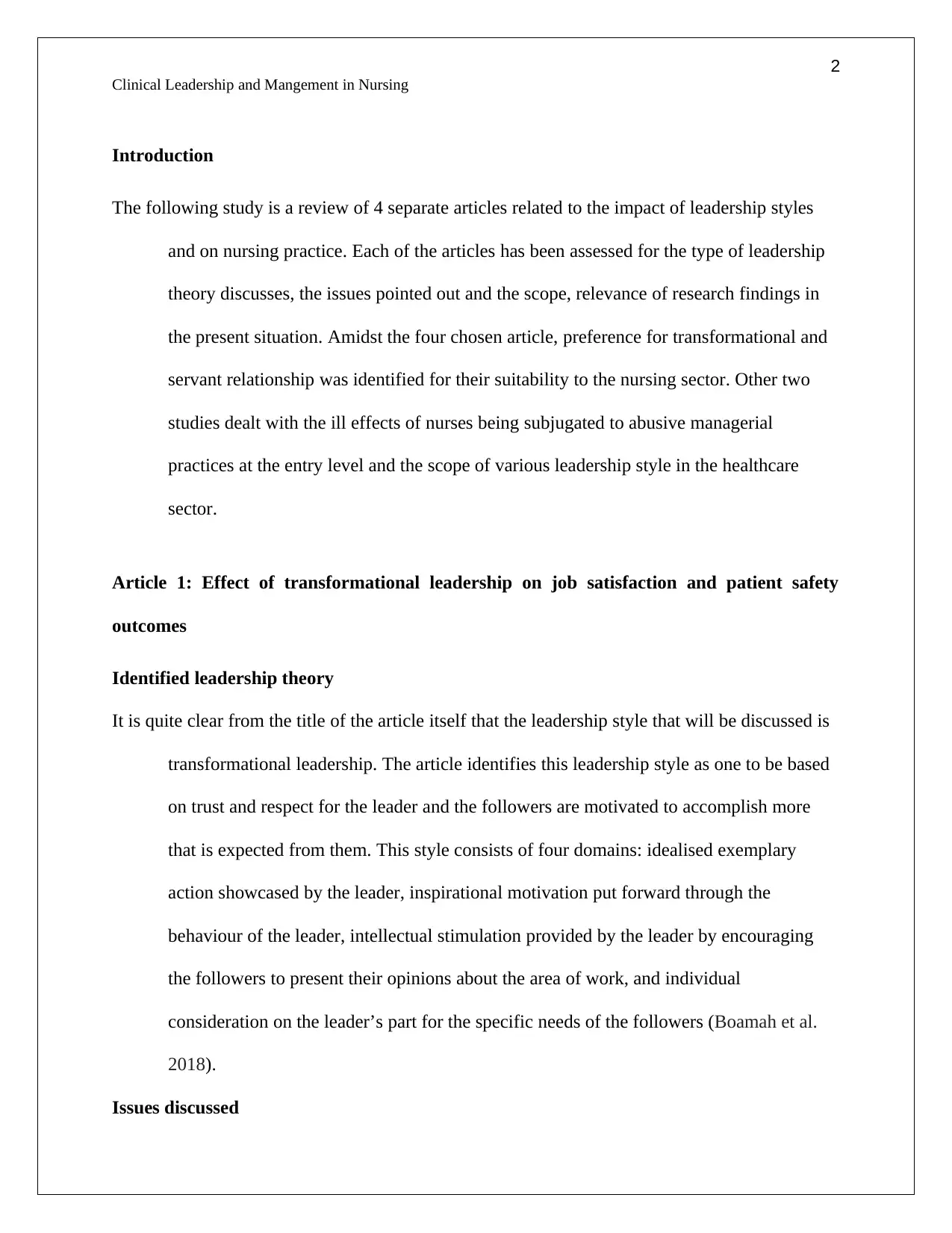
2
Clinical Leadership and Mangement in Nursing
Introduction
The following study is a review of 4 separate articles related to the impact of leadership styles
and on nursing practice. Each of the articles has been assessed for the type of leadership
theory discusses, the issues pointed out and the scope, relevance of research findings in
the present situation. Amidst the four chosen article, preference for transformational and
servant relationship was identified for their suitability to the nursing sector. Other two
studies dealt with the ill effects of nurses being subjugated to abusive managerial
practices at the entry level and the scope of various leadership style in the healthcare
sector.
Article 1: Effect of transformational leadership on job satisfaction and patient safety
outcomes
Identified leadership theory
It is quite clear from the title of the article itself that the leadership style that will be discussed is
transformational leadership. The article identifies this leadership style as one to be based
on trust and respect for the leader and the followers are motivated to accomplish more
that is expected from them. This style consists of four domains: idealised exemplary
action showcased by the leader, inspirational motivation put forward through the
behaviour of the leader, intellectual stimulation provided by the leader by encouraging
the followers to present their opinions about the area of work, and individual
consideration on the leader’s part for the specific needs of the followers (Boamah et al.
2018).
Issues discussed
Clinical Leadership and Mangement in Nursing
Introduction
The following study is a review of 4 separate articles related to the impact of leadership styles
and on nursing practice. Each of the articles has been assessed for the type of leadership
theory discusses, the issues pointed out and the scope, relevance of research findings in
the present situation. Amidst the four chosen article, preference for transformational and
servant relationship was identified for their suitability to the nursing sector. Other two
studies dealt with the ill effects of nurses being subjugated to abusive managerial
practices at the entry level and the scope of various leadership style in the healthcare
sector.
Article 1: Effect of transformational leadership on job satisfaction and patient safety
outcomes
Identified leadership theory
It is quite clear from the title of the article itself that the leadership style that will be discussed is
transformational leadership. The article identifies this leadership style as one to be based
on trust and respect for the leader and the followers are motivated to accomplish more
that is expected from them. This style consists of four domains: idealised exemplary
action showcased by the leader, inspirational motivation put forward through the
behaviour of the leader, intellectual stimulation provided by the leader by encouraging
the followers to present their opinions about the area of work, and individual
consideration on the leader’s part for the specific needs of the followers (Boamah et al.
2018).
Issues discussed
⊘ This is a preview!⊘
Do you want full access?
Subscribe today to unlock all pages.

Trusted by 1+ million students worldwide
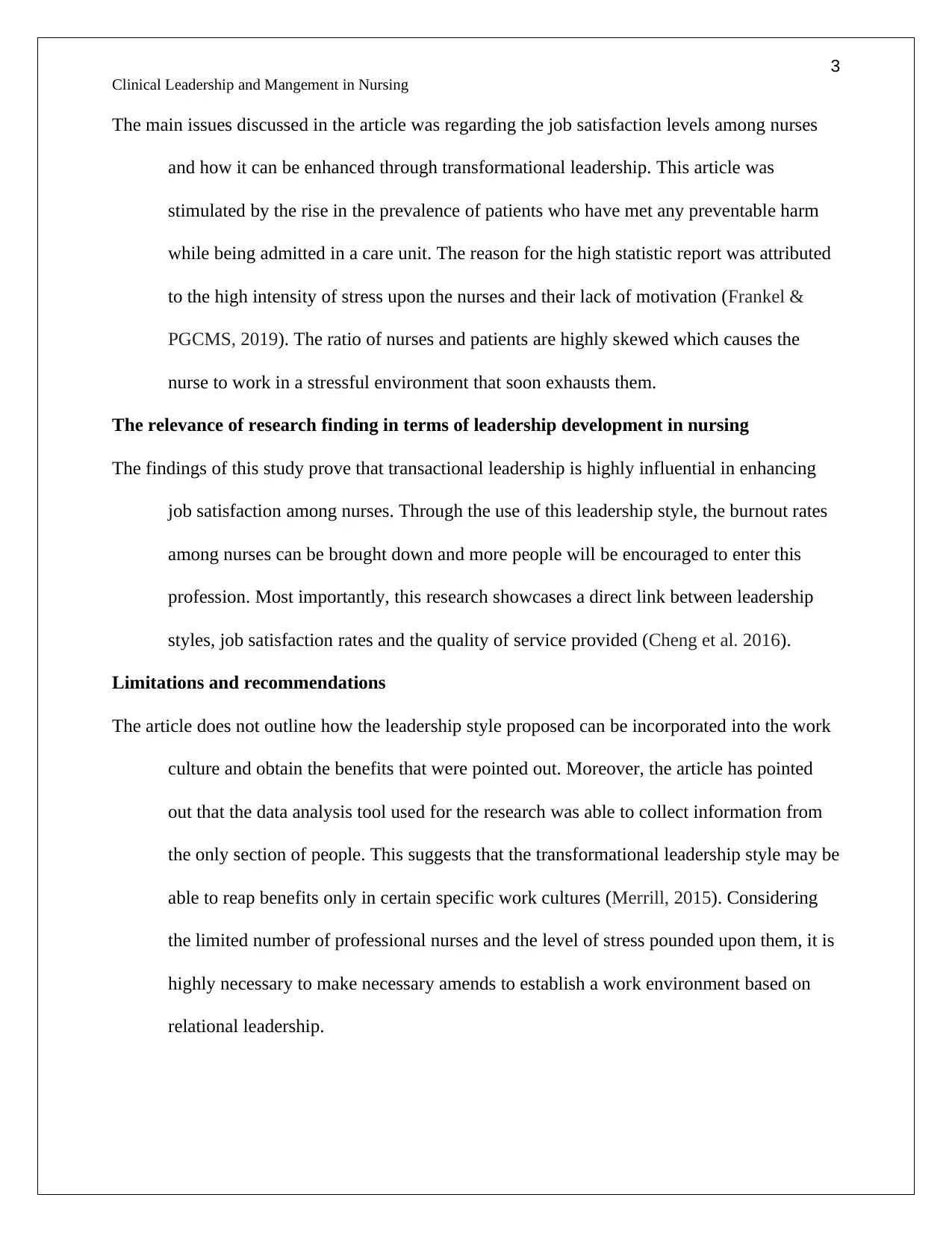
3
Clinical Leadership and Mangement in Nursing
The main issues discussed in the article was regarding the job satisfaction levels among nurses
and how it can be enhanced through transformational leadership. This article was
stimulated by the rise in the prevalence of patients who have met any preventable harm
while being admitted in a care unit. The reason for the high statistic report was attributed
to the high intensity of stress upon the nurses and their lack of motivation (Frankel &
PGCMS, 2019). The ratio of nurses and patients are highly skewed which causes the
nurse to work in a stressful environment that soon exhausts them.
The relevance of research finding in terms of leadership development in nursing
The findings of this study prove that transactional leadership is highly influential in enhancing
job satisfaction among nurses. Through the use of this leadership style, the burnout rates
among nurses can be brought down and more people will be encouraged to enter this
profession. Most importantly, this research showcases a direct link between leadership
styles, job satisfaction rates and the quality of service provided (Cheng et al. 2016).
Limitations and recommendations
The article does not outline how the leadership style proposed can be incorporated into the work
culture and obtain the benefits that were pointed out. Moreover, the article has pointed
out that the data analysis tool used for the research was able to collect information from
the only section of people. This suggests that the transformational leadership style may be
able to reap benefits only in certain specific work cultures (Merrill, 2015). Considering
the limited number of professional nurses and the level of stress pounded upon them, it is
highly necessary to make necessary amends to establish a work environment based on
relational leadership.
Clinical Leadership and Mangement in Nursing
The main issues discussed in the article was regarding the job satisfaction levels among nurses
and how it can be enhanced through transformational leadership. This article was
stimulated by the rise in the prevalence of patients who have met any preventable harm
while being admitted in a care unit. The reason for the high statistic report was attributed
to the high intensity of stress upon the nurses and their lack of motivation (Frankel &
PGCMS, 2019). The ratio of nurses and patients are highly skewed which causes the
nurse to work in a stressful environment that soon exhausts them.
The relevance of research finding in terms of leadership development in nursing
The findings of this study prove that transactional leadership is highly influential in enhancing
job satisfaction among nurses. Through the use of this leadership style, the burnout rates
among nurses can be brought down and more people will be encouraged to enter this
profession. Most importantly, this research showcases a direct link between leadership
styles, job satisfaction rates and the quality of service provided (Cheng et al. 2016).
Limitations and recommendations
The article does not outline how the leadership style proposed can be incorporated into the work
culture and obtain the benefits that were pointed out. Moreover, the article has pointed
out that the data analysis tool used for the research was able to collect information from
the only section of people. This suggests that the transformational leadership style may be
able to reap benefits only in certain specific work cultures (Merrill, 2015). Considering
the limited number of professional nurses and the level of stress pounded upon them, it is
highly necessary to make necessary amends to establish a work environment based on
relational leadership.
Paraphrase This Document
Need a fresh take? Get an instant paraphrase of this document with our AI Paraphraser
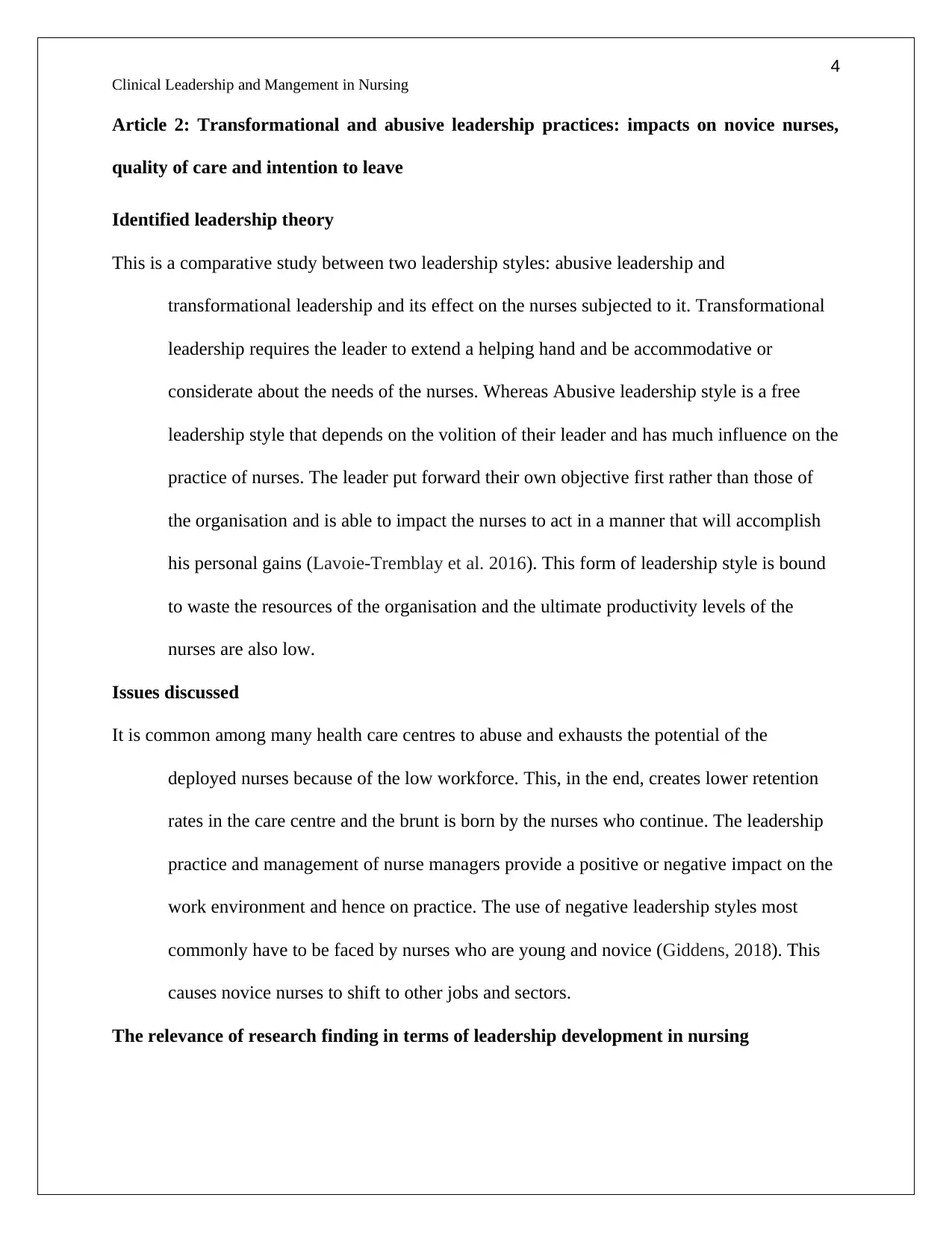
4
Clinical Leadership and Mangement in Nursing
Article 2: Transformational and abusive leadership practices: impacts on novice nurses,
quality of care and intention to leave
Identified leadership theory
This is a comparative study between two leadership styles: abusive leadership and
transformational leadership and its effect on the nurses subjected to it. Transformational
leadership requires the leader to extend a helping hand and be accommodative or
considerate about the needs of the nurses. Whereas Abusive leadership style is a free
leadership style that depends on the volition of their leader and has much influence on the
practice of nurses. The leader put forward their own objective first rather than those of
the organisation and is able to impact the nurses to act in a manner that will accomplish
his personal gains (Lavoie‐Tremblay et al. 2016). This form of leadership style is bound
to waste the resources of the organisation and the ultimate productivity levels of the
nurses are also low.
Issues discussed
It is common among many health care centres to abuse and exhausts the potential of the
deployed nurses because of the low workforce. This, in the end, creates lower retention
rates in the care centre and the brunt is born by the nurses who continue. The leadership
practice and management of nurse managers provide a positive or negative impact on the
work environment and hence on practice. The use of negative leadership styles most
commonly have to be faced by nurses who are young and novice (Giddens, 2018). This
causes novice nurses to shift to other jobs and sectors.
The relevance of research finding in terms of leadership development in nursing
Clinical Leadership and Mangement in Nursing
Article 2: Transformational and abusive leadership practices: impacts on novice nurses,
quality of care and intention to leave
Identified leadership theory
This is a comparative study between two leadership styles: abusive leadership and
transformational leadership and its effect on the nurses subjected to it. Transformational
leadership requires the leader to extend a helping hand and be accommodative or
considerate about the needs of the nurses. Whereas Abusive leadership style is a free
leadership style that depends on the volition of their leader and has much influence on the
practice of nurses. The leader put forward their own objective first rather than those of
the organisation and is able to impact the nurses to act in a manner that will accomplish
his personal gains (Lavoie‐Tremblay et al. 2016). This form of leadership style is bound
to waste the resources of the organisation and the ultimate productivity levels of the
nurses are also low.
Issues discussed
It is common among many health care centres to abuse and exhausts the potential of the
deployed nurses because of the low workforce. This, in the end, creates lower retention
rates in the care centre and the brunt is born by the nurses who continue. The leadership
practice and management of nurse managers provide a positive or negative impact on the
work environment and hence on practice. The use of negative leadership styles most
commonly have to be faced by nurses who are young and novice (Giddens, 2018). This
causes novice nurses to shift to other jobs and sectors.
The relevance of research finding in terms of leadership development in nursing
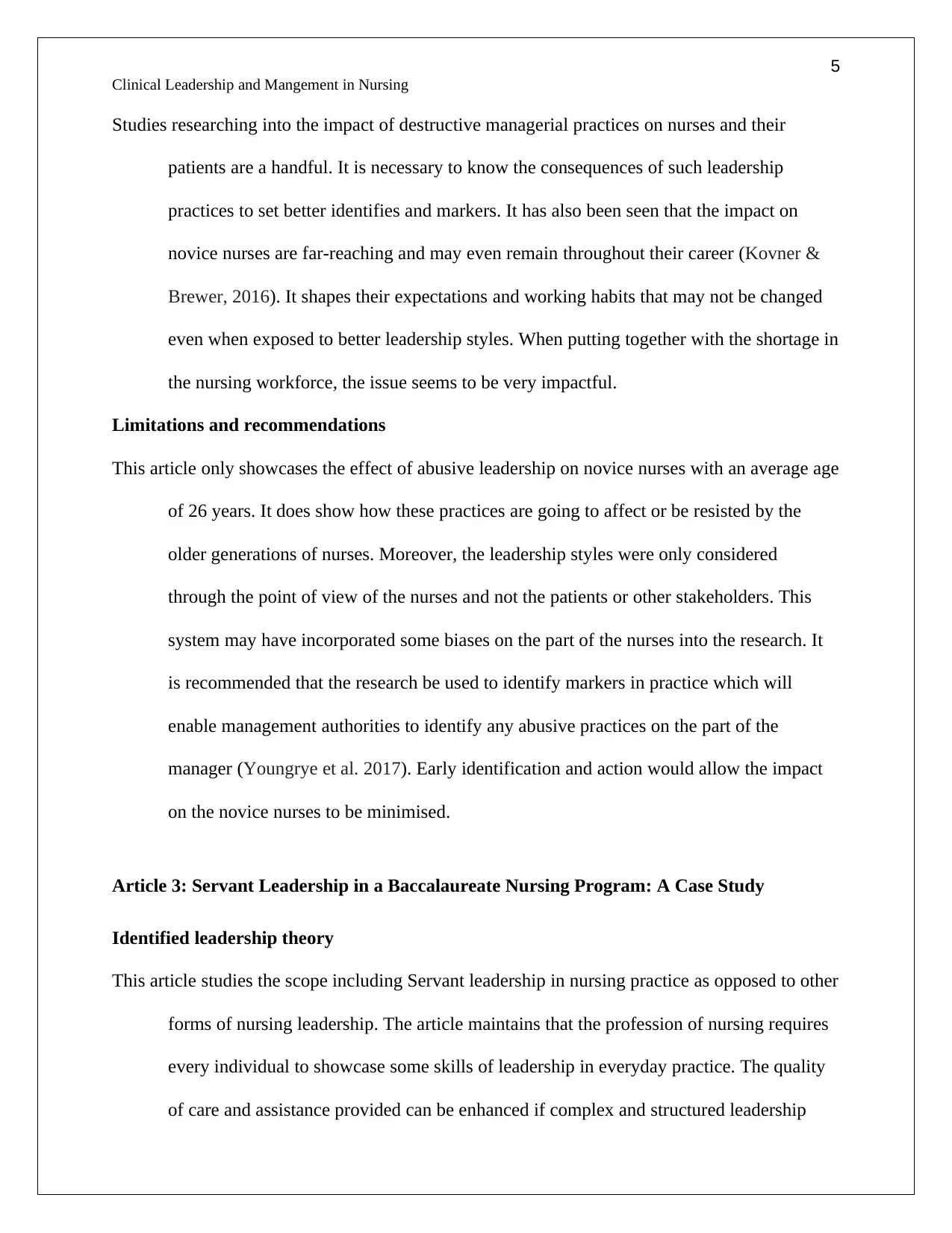
5
Clinical Leadership and Mangement in Nursing
Studies researching into the impact of destructive managerial practices on nurses and their
patients are a handful. It is necessary to know the consequences of such leadership
practices to set better identifies and markers. It has also been seen that the impact on
novice nurses are far-reaching and may even remain throughout their career (Kovner &
Brewer, 2016). It shapes their expectations and working habits that may not be changed
even when exposed to better leadership styles. When putting together with the shortage in
the nursing workforce, the issue seems to be very impactful.
Limitations and recommendations
This article only showcases the effect of abusive leadership on novice nurses with an average age
of 26 years. It does show how these practices are going to affect or be resisted by the
older generations of nurses. Moreover, the leadership styles were only considered
through the point of view of the nurses and not the patients or other stakeholders. This
system may have incorporated some biases on the part of the nurses into the research. It
is recommended that the research be used to identify markers in practice which will
enable management authorities to identify any abusive practices on the part of the
manager (Youngrye et al. 2017). Early identification and action would allow the impact
on the novice nurses to be minimised.
Article 3: Servant Leadership in a Baccalaureate Nursing Program: A Case Study
Identified leadership theory
This article studies the scope including Servant leadership in nursing practice as opposed to other
forms of nursing leadership. The article maintains that the profession of nursing requires
every individual to showcase some skills of leadership in everyday practice. The quality
of care and assistance provided can be enhanced if complex and structured leadership
Clinical Leadership and Mangement in Nursing
Studies researching into the impact of destructive managerial practices on nurses and their
patients are a handful. It is necessary to know the consequences of such leadership
practices to set better identifies and markers. It has also been seen that the impact on
novice nurses are far-reaching and may even remain throughout their career (Kovner &
Brewer, 2016). It shapes their expectations and working habits that may not be changed
even when exposed to better leadership styles. When putting together with the shortage in
the nursing workforce, the issue seems to be very impactful.
Limitations and recommendations
This article only showcases the effect of abusive leadership on novice nurses with an average age
of 26 years. It does show how these practices are going to affect or be resisted by the
older generations of nurses. Moreover, the leadership styles were only considered
through the point of view of the nurses and not the patients or other stakeholders. This
system may have incorporated some biases on the part of the nurses into the research. It
is recommended that the research be used to identify markers in practice which will
enable management authorities to identify any abusive practices on the part of the
manager (Youngrye et al. 2017). Early identification and action would allow the impact
on the novice nurses to be minimised.
Article 3: Servant Leadership in a Baccalaureate Nursing Program: A Case Study
Identified leadership theory
This article studies the scope including Servant leadership in nursing practice as opposed to other
forms of nursing leadership. The article maintains that the profession of nursing requires
every individual to showcase some skills of leadership in everyday practice. The quality
of care and assistance provided can be enhanced if complex and structured leadership
⊘ This is a preview!⊘
Do you want full access?
Subscribe today to unlock all pages.

Trusted by 1+ million students worldwide
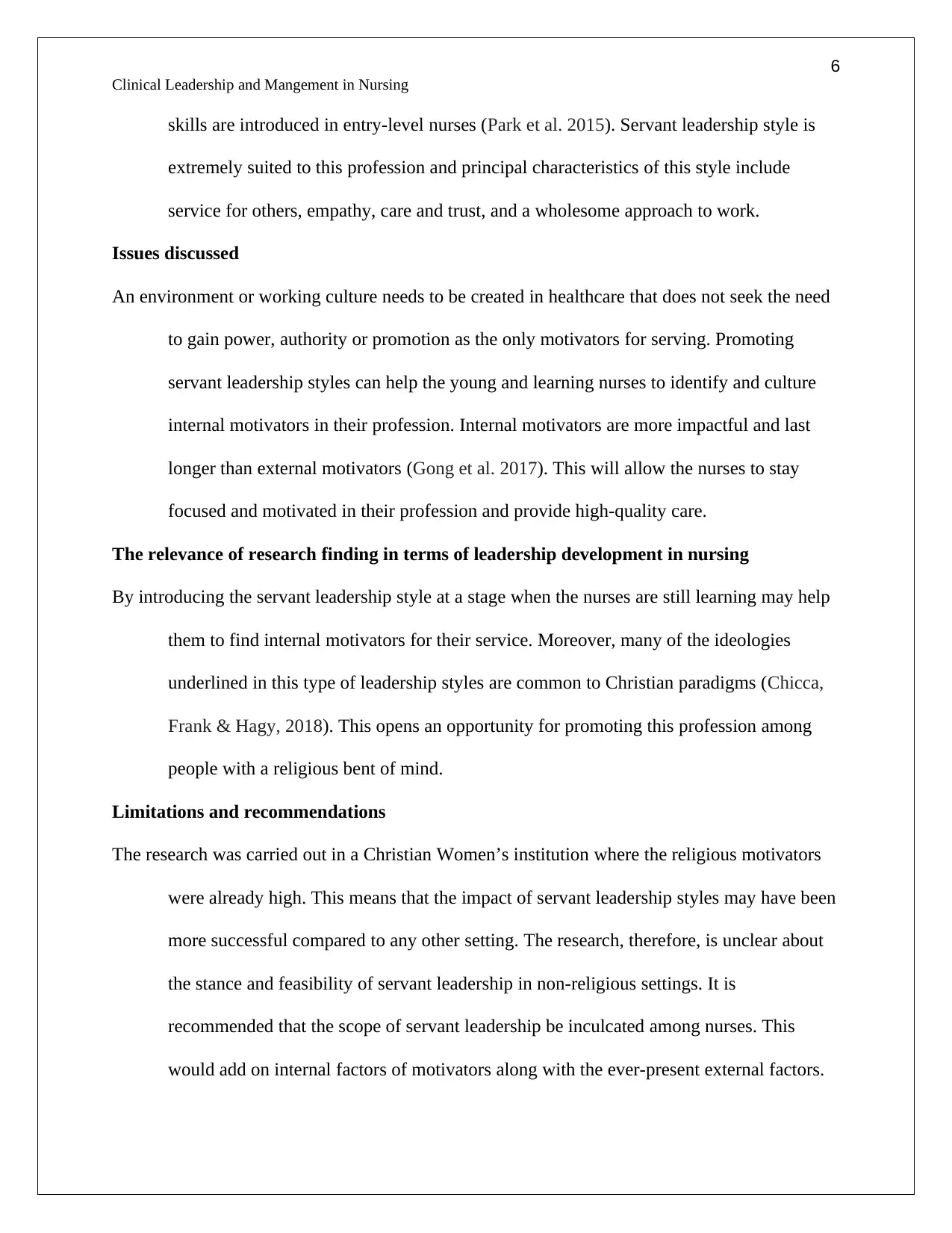
6
Clinical Leadership and Mangement in Nursing
skills are introduced in entry-level nurses (Park et al. 2015). Servant leadership style is
extremely suited to this profession and principal characteristics of this style include
service for others, empathy, care and trust, and a wholesome approach to work.
Issues discussed
An environment or working culture needs to be created in healthcare that does not seek the need
to gain power, authority or promotion as the only motivators for serving. Promoting
servant leadership styles can help the young and learning nurses to identify and culture
internal motivators in their profession. Internal motivators are more impactful and last
longer than external motivators (Gong et al. 2017). This will allow the nurses to stay
focused and motivated in their profession and provide high-quality care.
The relevance of research finding in terms of leadership development in nursing
By introducing the servant leadership style at a stage when the nurses are still learning may help
them to find internal motivators for their service. Moreover, many of the ideologies
underlined in this type of leadership styles are common to Christian paradigms (Chicca,
Frank & Hagy, 2018). This opens an opportunity for promoting this profession among
people with a religious bent of mind.
Limitations and recommendations
The research was carried out in a Christian Women’s institution where the religious motivators
were already high. This means that the impact of servant leadership styles may have been
more successful compared to any other setting. The research, therefore, is unclear about
the stance and feasibility of servant leadership in non-religious settings. It is
recommended that the scope of servant leadership be inculcated among nurses. This
would add on internal factors of motivators along with the ever-present external factors.
Clinical Leadership and Mangement in Nursing
skills are introduced in entry-level nurses (Park et al. 2015). Servant leadership style is
extremely suited to this profession and principal characteristics of this style include
service for others, empathy, care and trust, and a wholesome approach to work.
Issues discussed
An environment or working culture needs to be created in healthcare that does not seek the need
to gain power, authority or promotion as the only motivators for serving. Promoting
servant leadership styles can help the young and learning nurses to identify and culture
internal motivators in their profession. Internal motivators are more impactful and last
longer than external motivators (Gong et al. 2017). This will allow the nurses to stay
focused and motivated in their profession and provide high-quality care.
The relevance of research finding in terms of leadership development in nursing
By introducing the servant leadership style at a stage when the nurses are still learning may help
them to find internal motivators for their service. Moreover, many of the ideologies
underlined in this type of leadership styles are common to Christian paradigms (Chicca,
Frank & Hagy, 2018). This opens an opportunity for promoting this profession among
people with a religious bent of mind.
Limitations and recommendations
The research was carried out in a Christian Women’s institution where the religious motivators
were already high. This means that the impact of servant leadership styles may have been
more successful compared to any other setting. The research, therefore, is unclear about
the stance and feasibility of servant leadership in non-religious settings. It is
recommended that the scope of servant leadership be inculcated among nurses. This
would add on internal factors of motivators along with the ever-present external factors.
Paraphrase This Document
Need a fresh take? Get an instant paraphrase of this document with our AI Paraphraser
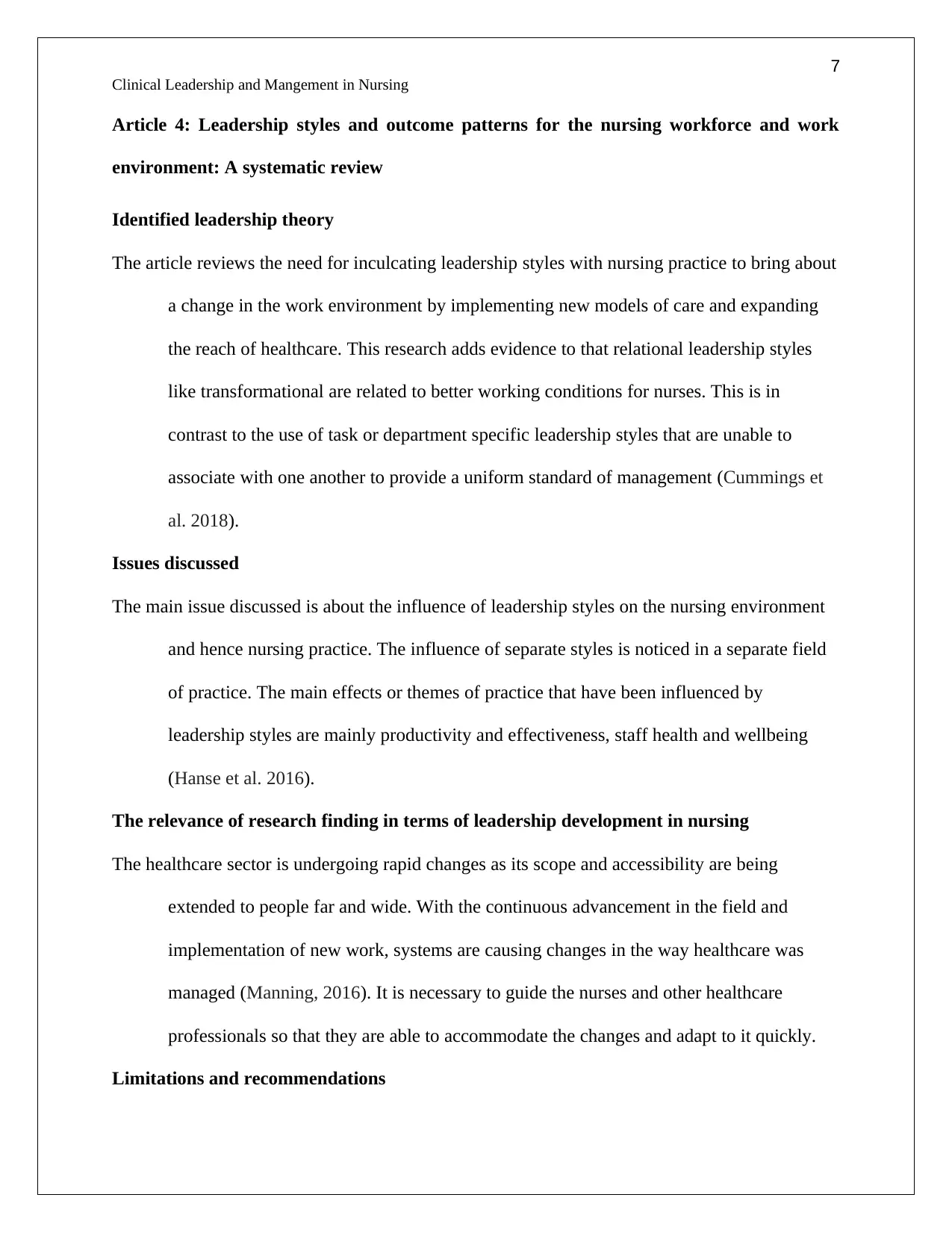
7
Clinical Leadership and Mangement in Nursing
Article 4: Leadership styles and outcome patterns for the nursing workforce and work
environment: A systematic review
Identified leadership theory
The article reviews the need for inculcating leadership styles with nursing practice to bring about
a change in the work environment by implementing new models of care and expanding
the reach of healthcare. This research adds evidence to that relational leadership styles
like transformational are related to better working conditions for nurses. This is in
contrast to the use of task or department specific leadership styles that are unable to
associate with one another to provide a uniform standard of management (Cummings et
al. 2018).
Issues discussed
The main issue discussed is about the influence of leadership styles on the nursing environment
and hence nursing practice. The influence of separate styles is noticed in a separate field
of practice. The main effects or themes of practice that have been influenced by
leadership styles are mainly productivity and effectiveness, staff health and wellbeing
(Hanse et al. 2016).
The relevance of research finding in terms of leadership development in nursing
The healthcare sector is undergoing rapid changes as its scope and accessibility are being
extended to people far and wide. With the continuous advancement in the field and
implementation of new work, systems are causing changes in the way healthcare was
managed (Manning, 2016). It is necessary to guide the nurses and other healthcare
professionals so that they are able to accommodate the changes and adapt to it quickly.
Limitations and recommendations
Clinical Leadership and Mangement in Nursing
Article 4: Leadership styles and outcome patterns for the nursing workforce and work
environment: A systematic review
Identified leadership theory
The article reviews the need for inculcating leadership styles with nursing practice to bring about
a change in the work environment by implementing new models of care and expanding
the reach of healthcare. This research adds evidence to that relational leadership styles
like transformational are related to better working conditions for nurses. This is in
contrast to the use of task or department specific leadership styles that are unable to
associate with one another to provide a uniform standard of management (Cummings et
al. 2018).
Issues discussed
The main issue discussed is about the influence of leadership styles on the nursing environment
and hence nursing practice. The influence of separate styles is noticed in a separate field
of practice. The main effects or themes of practice that have been influenced by
leadership styles are mainly productivity and effectiveness, staff health and wellbeing
(Hanse et al. 2016).
The relevance of research finding in terms of leadership development in nursing
The healthcare sector is undergoing rapid changes as its scope and accessibility are being
extended to people far and wide. With the continuous advancement in the field and
implementation of new work, systems are causing changes in the way healthcare was
managed (Manning, 2016). It is necessary to guide the nurses and other healthcare
professionals so that they are able to accommodate the changes and adapt to it quickly.
Limitations and recommendations
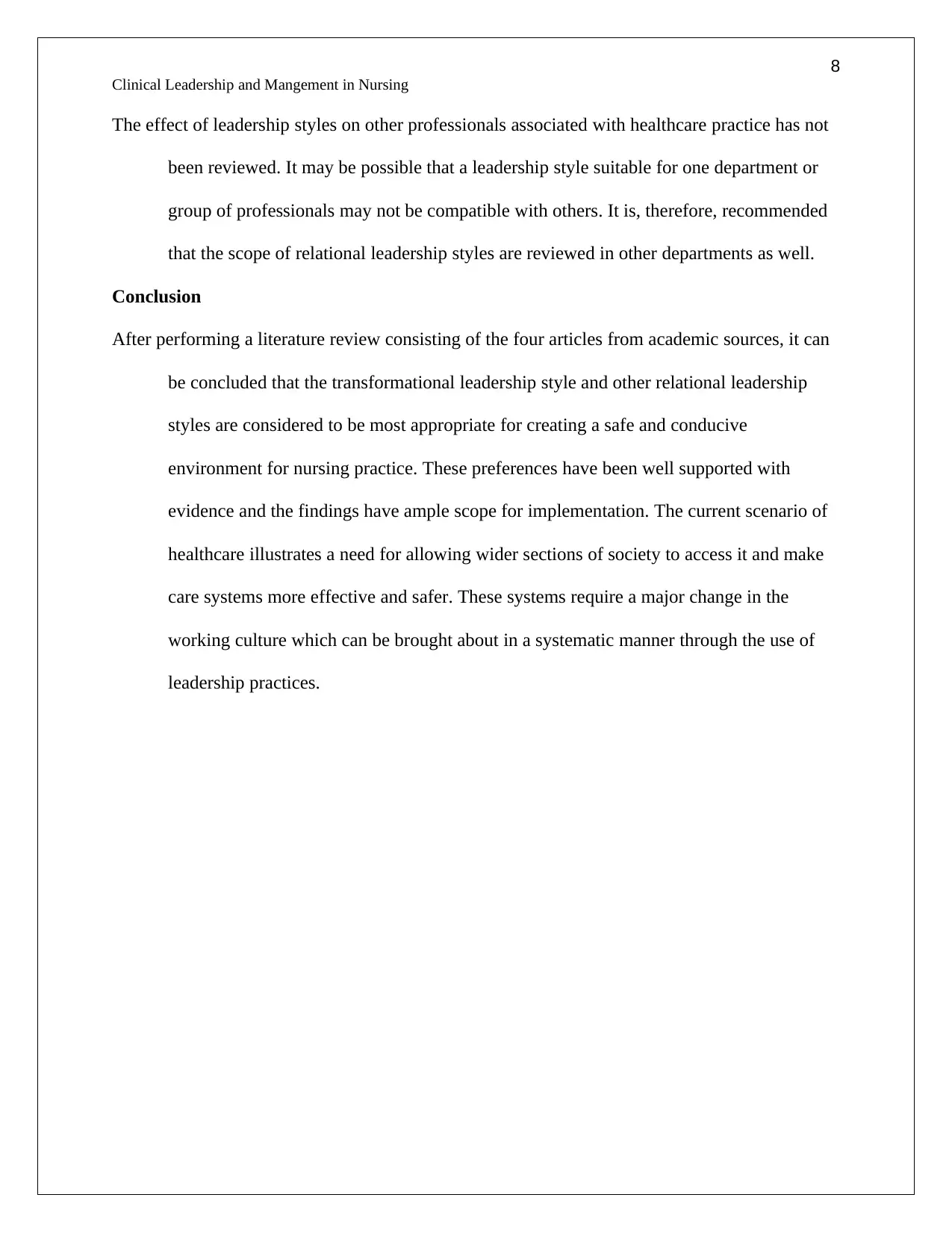
8
Clinical Leadership and Mangement in Nursing
The effect of leadership styles on other professionals associated with healthcare practice has not
been reviewed. It may be possible that a leadership style suitable for one department or
group of professionals may not be compatible with others. It is, therefore, recommended
that the scope of relational leadership styles are reviewed in other departments as well.
Conclusion
After performing a literature review consisting of the four articles from academic sources, it can
be concluded that the transformational leadership style and other relational leadership
styles are considered to be most appropriate for creating a safe and conducive
environment for nursing practice. These preferences have been well supported with
evidence and the findings have ample scope for implementation. The current scenario of
healthcare illustrates a need for allowing wider sections of society to access it and make
care systems more effective and safer. These systems require a major change in the
working culture which can be brought about in a systematic manner through the use of
leadership practices.
Clinical Leadership and Mangement in Nursing
The effect of leadership styles on other professionals associated with healthcare practice has not
been reviewed. It may be possible that a leadership style suitable for one department or
group of professionals may not be compatible with others. It is, therefore, recommended
that the scope of relational leadership styles are reviewed in other departments as well.
Conclusion
After performing a literature review consisting of the four articles from academic sources, it can
be concluded that the transformational leadership style and other relational leadership
styles are considered to be most appropriate for creating a safe and conducive
environment for nursing practice. These preferences have been well supported with
evidence and the findings have ample scope for implementation. The current scenario of
healthcare illustrates a need for allowing wider sections of society to access it and make
care systems more effective and safer. These systems require a major change in the
working culture which can be brought about in a systematic manner through the use of
leadership practices.
⊘ This is a preview!⊘
Do you want full access?
Subscribe today to unlock all pages.

Trusted by 1+ million students worldwide
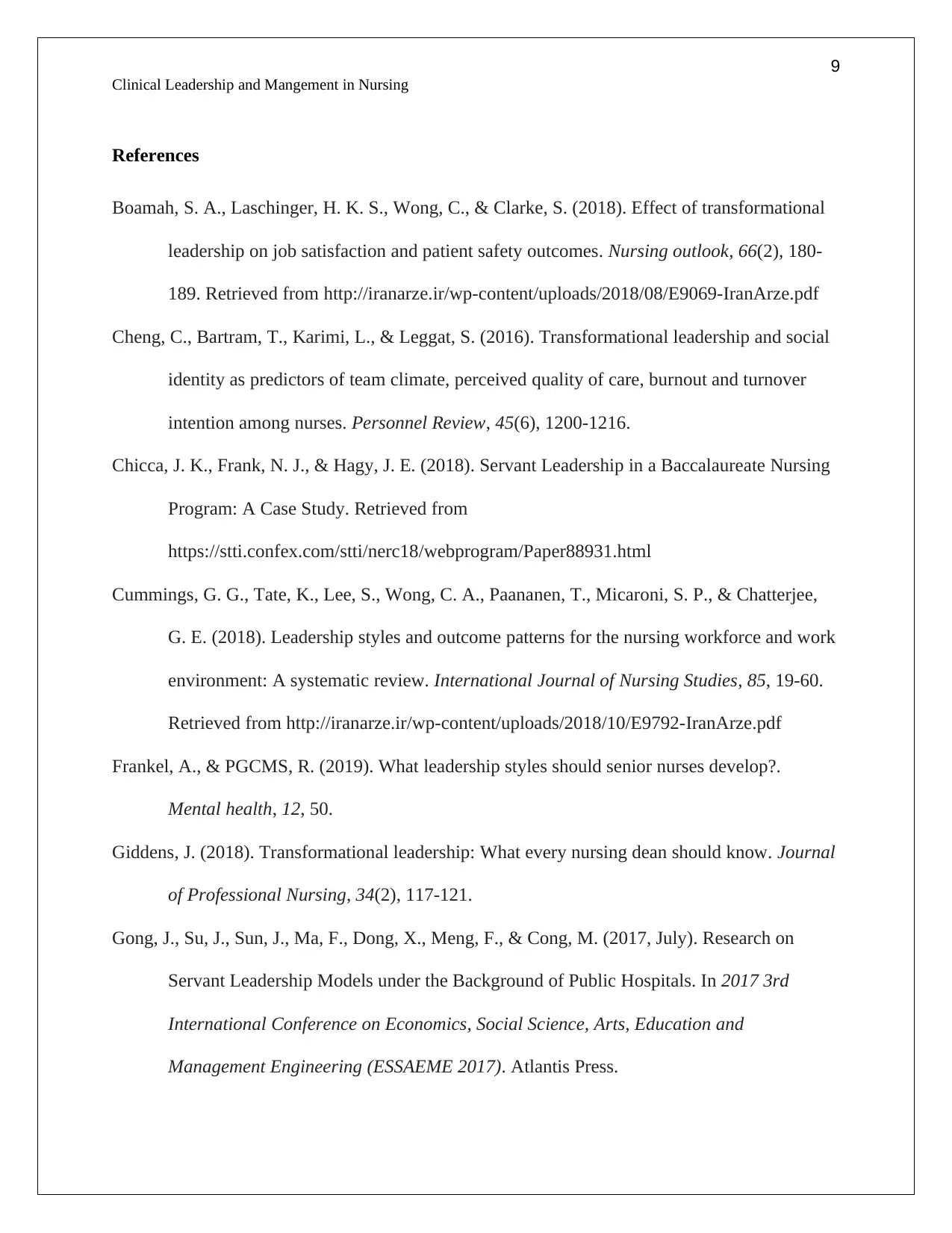
9
Clinical Leadership and Mangement in Nursing
References
Boamah, S. A., Laschinger, H. K. S., Wong, C., & Clarke, S. (2018). Effect of transformational
leadership on job satisfaction and patient safety outcomes. Nursing outlook, 66(2), 180-
189. Retrieved from http://iranarze.ir/wp-content/uploads/2018/08/E9069-IranArze.pdf
Cheng, C., Bartram, T., Karimi, L., & Leggat, S. (2016). Transformational leadership and social
identity as predictors of team climate, perceived quality of care, burnout and turnover
intention among nurses. Personnel Review, 45(6), 1200-1216.
Chicca, J. K., Frank, N. J., & Hagy, J. E. (2018). Servant Leadership in a Baccalaureate Nursing
Program: A Case Study. Retrieved from
https://stti.confex.com/stti/nerc18/webprogram/Paper88931.html
Cummings, G. G., Tate, K., Lee, S., Wong, C. A., Paananen, T., Micaroni, S. P., & Chatterjee,
G. E. (2018). Leadership styles and outcome patterns for the nursing workforce and work
environment: A systematic review. International Journal of Nursing Studies, 85, 19-60.
Retrieved from http://iranarze.ir/wp-content/uploads/2018/10/E9792-IranArze.pdf
Frankel, A., & PGCMS, R. (2019). What leadership styles should senior nurses develop?.
Mental health, 12, 50.
Giddens, J. (2018). Transformational leadership: What every nursing dean should know. Journal
of Professional Nursing, 34(2), 117-121.
Gong, J., Su, J., Sun, J., Ma, F., Dong, X., Meng, F., & Cong, M. (2017, July). Research on
Servant Leadership Models under the Background of Public Hospitals. In 2017 3rd
International Conference on Economics, Social Science, Arts, Education and
Management Engineering (ESSAEME 2017). Atlantis Press.
Clinical Leadership and Mangement in Nursing
References
Boamah, S. A., Laschinger, H. K. S., Wong, C., & Clarke, S. (2018). Effect of transformational
leadership on job satisfaction and patient safety outcomes. Nursing outlook, 66(2), 180-
189. Retrieved from http://iranarze.ir/wp-content/uploads/2018/08/E9069-IranArze.pdf
Cheng, C., Bartram, T., Karimi, L., & Leggat, S. (2016). Transformational leadership and social
identity as predictors of team climate, perceived quality of care, burnout and turnover
intention among nurses. Personnel Review, 45(6), 1200-1216.
Chicca, J. K., Frank, N. J., & Hagy, J. E. (2018). Servant Leadership in a Baccalaureate Nursing
Program: A Case Study. Retrieved from
https://stti.confex.com/stti/nerc18/webprogram/Paper88931.html
Cummings, G. G., Tate, K., Lee, S., Wong, C. A., Paananen, T., Micaroni, S. P., & Chatterjee,
G. E. (2018). Leadership styles and outcome patterns for the nursing workforce and work
environment: A systematic review. International Journal of Nursing Studies, 85, 19-60.
Retrieved from http://iranarze.ir/wp-content/uploads/2018/10/E9792-IranArze.pdf
Frankel, A., & PGCMS, R. (2019). What leadership styles should senior nurses develop?.
Mental health, 12, 50.
Giddens, J. (2018). Transformational leadership: What every nursing dean should know. Journal
of Professional Nursing, 34(2), 117-121.
Gong, J., Su, J., Sun, J., Ma, F., Dong, X., Meng, F., & Cong, M. (2017, July). Research on
Servant Leadership Models under the Background of Public Hospitals. In 2017 3rd
International Conference on Economics, Social Science, Arts, Education and
Management Engineering (ESSAEME 2017). Atlantis Press.
Paraphrase This Document
Need a fresh take? Get an instant paraphrase of this document with our AI Paraphraser
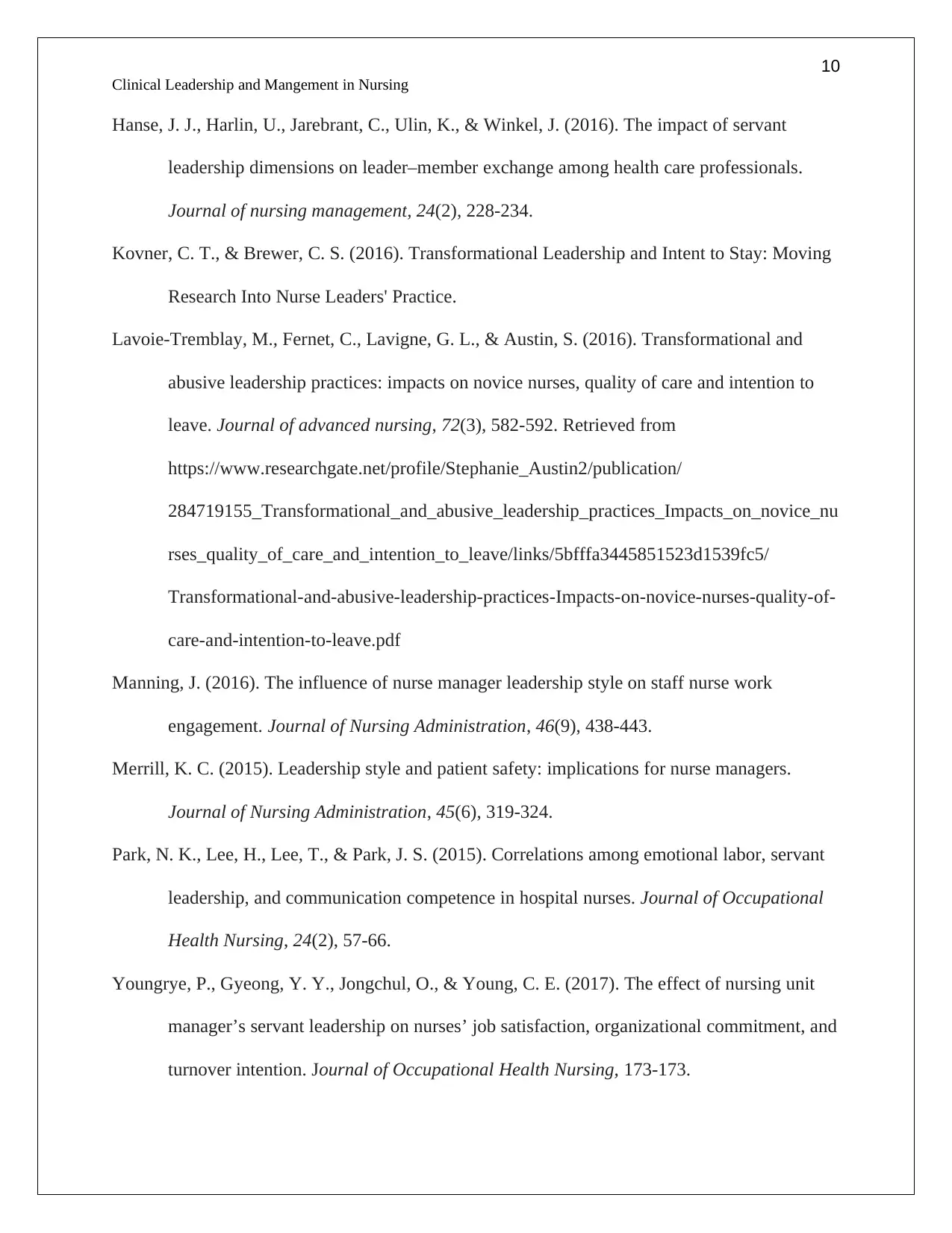
10
Clinical Leadership and Mangement in Nursing
Hanse, J. J., Harlin, U., Jarebrant, C., Ulin, K., & Winkel, J. (2016). The impact of servant
leadership dimensions on leader–member exchange among health care professionals.
Journal of nursing management, 24(2), 228-234.
Kovner, C. T., & Brewer, C. S. (2016). Transformational Leadership and Intent to Stay: Moving
Research Into Nurse Leaders' Practice.
Lavoie‐Tremblay, M., Fernet, C., Lavigne, G. L., & Austin, S. (2016). Transformational and
abusive leadership practices: impacts on novice nurses, quality of care and intention to
leave. Journal of advanced nursing, 72(3), 582-592. Retrieved from
https://www.researchgate.net/profile/Stephanie_Austin2/publication/
284719155_Transformational_and_abusive_leadership_practices_Impacts_on_novice_nu
rses_quality_of_care_and_intention_to_leave/links/5bfffa3445851523d1539fc5/
Transformational-and-abusive-leadership-practices-Impacts-on-novice-nurses-quality-of-
care-and-intention-to-leave.pdf
Manning, J. (2016). The influence of nurse manager leadership style on staff nurse work
engagement. Journal of Nursing Administration, 46(9), 438-443.
Merrill, K. C. (2015). Leadership style and patient safety: implications for nurse managers.
Journal of Nursing Administration, 45(6), 319-324.
Park, N. K., Lee, H., Lee, T., & Park, J. S. (2015). Correlations among emotional labor, servant
leadership, and communication competence in hospital nurses. Journal of Occupational
Health Nursing, 24(2), 57-66.
Youngrye, P., Gyeong, Y. Y., Jongchul, O., & Young, C. E. (2017). The effect of nursing unit
manager’s servant leadership on nurses’ job satisfaction, organizational commitment, and
turnover intention. Journal of Occupational Health Nursing, 173-173.
Clinical Leadership and Mangement in Nursing
Hanse, J. J., Harlin, U., Jarebrant, C., Ulin, K., & Winkel, J. (2016). The impact of servant
leadership dimensions on leader–member exchange among health care professionals.
Journal of nursing management, 24(2), 228-234.
Kovner, C. T., & Brewer, C. S. (2016). Transformational Leadership and Intent to Stay: Moving
Research Into Nurse Leaders' Practice.
Lavoie‐Tremblay, M., Fernet, C., Lavigne, G. L., & Austin, S. (2016). Transformational and
abusive leadership practices: impacts on novice nurses, quality of care and intention to
leave. Journal of advanced nursing, 72(3), 582-592. Retrieved from
https://www.researchgate.net/profile/Stephanie_Austin2/publication/
284719155_Transformational_and_abusive_leadership_practices_Impacts_on_novice_nu
rses_quality_of_care_and_intention_to_leave/links/5bfffa3445851523d1539fc5/
Transformational-and-abusive-leadership-practices-Impacts-on-novice-nurses-quality-of-
care-and-intention-to-leave.pdf
Manning, J. (2016). The influence of nurse manager leadership style on staff nurse work
engagement. Journal of Nursing Administration, 46(9), 438-443.
Merrill, K. C. (2015). Leadership style and patient safety: implications for nurse managers.
Journal of Nursing Administration, 45(6), 319-324.
Park, N. K., Lee, H., Lee, T., & Park, J. S. (2015). Correlations among emotional labor, servant
leadership, and communication competence in hospital nurses. Journal of Occupational
Health Nursing, 24(2), 57-66.
Youngrye, P., Gyeong, Y. Y., Jongchul, O., & Young, C. E. (2017). The effect of nursing unit
manager’s servant leadership on nurses’ job satisfaction, organizational commitment, and
turnover intention. Journal of Occupational Health Nursing, 173-173.
1 out of 11
Related Documents
Your All-in-One AI-Powered Toolkit for Academic Success.
+13062052269
info@desklib.com
Available 24*7 on WhatsApp / Email
![[object Object]](/_next/static/media/star-bottom.7253800d.svg)
Unlock your academic potential
Copyright © 2020–2025 A2Z Services. All Rights Reserved. Developed and managed by ZUCOL.




